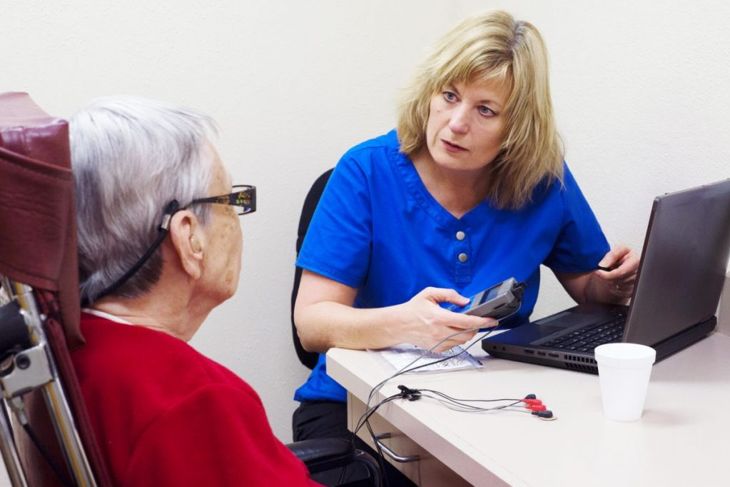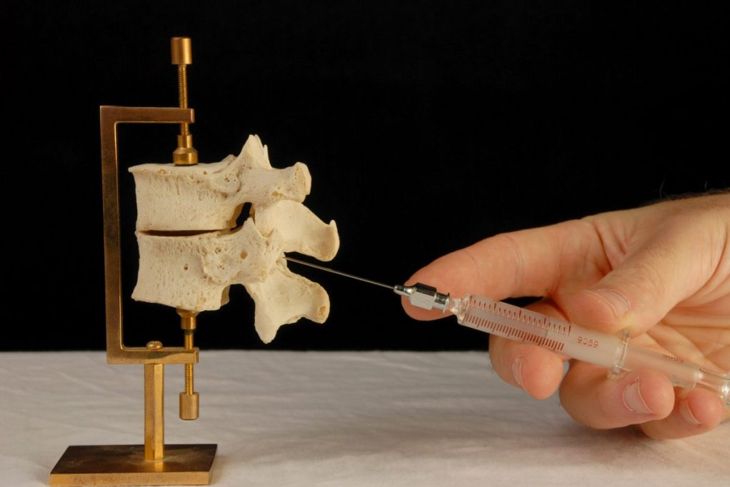Also known as spinal osteoarthritis, spondylosis is a degenerative condition that affects the spine. Cervical spondylosis specifically affects the neck. Constant, sports-induced stress and bad posture can be the cause, but age-related wear and tear are the most common. The spinal discs lose shape, resulting in less space between the vertebrae. Most people experience no symptoms, but some may have pain or stiffness. Rarely, bone growth may pinch a nerve or the spinal cord, leading to issues such as numbness or lack of coordination. There are many treatment options for cervical spondylosis and most people do not require surgery.
Temperature Massages
Physical therapy can help reduce pain, increase mobility, and strengthen the muscles of the spine. This stretches the muscles and reduces the load on the affected area. Physical therapy may sometimes include a hot or cold massage. The therapist places a heating pad or steamed towel on the neck to warm the muscles. This increases the blood flow of the area and relaxes the muscles. A gentle massage amplifies the effects. In cryotherapy, the therapist may place an ice pack on the area, or spray the site with a coolant. This can reduce muscle spasms, inflammation, and swelling.
Electrical Stimulation
Another form of physical therapy uses electrical stimulation to treat muscle spasms and pain. Transcutaneous electrical stimulation or TENS is the most common form of electrical stimulation doctors use to treat cervical spondylosis. The therapist or medical practitioner places electrodes on the skin and administers controlled impulses of electricity. Studies show TENS to be effective, though many experts debate whether its benefits are the result of an unknown underlying mechanism or the placebo effect.
Anti-Inflammatory Drugs
Cervical spondylosis shares many treatment options with osteoarthritis because the latter is a common cause of the former. Doctors often use nonsteroidal anti-inflammatory drugs to treat the pain brought on by both conditions. By blocking the enzymes responsible for inflammation, the drugs can alleviate pain and prevent fevers. However, anti-inflammatory drugs do have some side effects. Some individuals experience stomach pain, headaches, and increased blood pressure. Additionally, it is possible to be allergic to these medications.
Muscle Relaxants
Spondylosis can make the muscles of the neck and spine work harder to support the head, which can lead to overworked and tense muscles that are prone to spasms. Muscle relaxants affect the neuronal signals that cause muscle contractions. Due to their strength, prescription muscle relaxants can be addictive and have serious effects. The worst side effects are heart failure and paralysis, while the most common is sedation. A person looking for relief should have an in-depth conversation with their doctor about the risks of muscle relaxants before accepting the prescription.
Soft Cervical Collar
Some individuals may find relief with a soft neck brace or cervical collar. These collars provide relief by supporting the head and preventing excess neck movements. Typically, the soft brace of a comfortable material such as felt fits under the jaw. Some studies show the possibility of adverse effects following the extended use of a cervical collar. Most doctors consider it safe to use them temporarily to provide relief. And some medical centers may pair a cervical collar with physical therapy for amplified results.
Radiofrequency Ablation
Similar to TENS physical therapy, radiofrequency ablation uses electricity to treat pain. First, the medical professional relaxes the patient with intravenous medication. Then they numb the neck with an anesthetic. The doctor inserts a thin needle into the skin and then transfers a microelectrode through the needle. That electrode receives a radiofrequency current to heat the surrounding nerve tissue. Radiofrequency ablation stops the treated area from sending pain signals and can last for up to a year.
Steroid Injections
Occasionally, a doctor may feel that the best way to treat cervical spondylosis is with a steroid injection. The most common injection is an epidural block, though there are many other types. The doctor inserts an epidural block into the epidural space of the spine, an area with many nerve roots. A doctor can treat the pain and stiffness of spondylosis by injecting this area with steroids — essentially powerful anti-inflammatory drugs that effectively relieve pain caused by swollen or pinched nerve roots.
Decompression Surgery
Occasionally, a steroid injection is not strong enough to ease the pain of a pinched nerve. If this is the case, the next best option is surgery, of which there are two traditional options for spondylosis. The first is decompression surgery, which involves the removal of tissue pressing on a nerve. Surgeons perform decompression surgeries, including facetectomies or laminectomies, from the posterior of the spine. If the spinal cord is in the way, they may need to perform surgery from the front instead, with a corpectomy.
Stabilization Surgery
The other surgical option for spondylosis is stabilization surgery, which typically follows decompression surgeries to ensure the removed tissue does not result in the spine moving unnaturally. The most common forms of spinal stabilization are fusions. A surgeon uses a bone graft or another biological substance to allow the spine to fuse over the recovery period. He or she will often use screws, pins, and wires to keep the spine stable while the bones fuse.
Light Exercise
Depending on the severity of cervical spondylosis, some people may be able to perform light exercises to assist doctors in treating their condition. Exercises such as chin tucks and side-to-side rotations can help strengthen the neck muscles. It is important to receive a doctor’s approval before attempting these exercises because even the gentlest forms of exercise can cause damage in some instances. If the neck feels overstrained or fatigued, cervical spondylosis symptoms may worsen with additional exercise.

 Home
Home Health
Health Diet & Nutrition
Diet & Nutrition Living Well
Living Well More
More




















